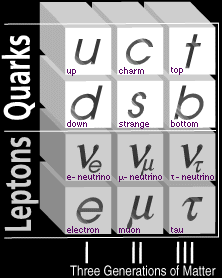
In the
standard
theory (behind this link is a longer, illustrated story, you may have to click in the upper right corner on invisible > and < buttons.) of elementary particles the basic matter elements are
quarks and leptons in three generations I, II and III, as indicated below:

In addition there are the force carrier particles, the photon, W, Z and the gluon. The main open question is the existence of the Higgs particle or field (well, the theory has some 20 parameters the values of which the theory leave open). The Higgs field is a kind of stuff in the vacuum causing originally zero mass particles to gain mass. In the electro-weak theory the photon (and the gluon in the quark theory) remain massless. The creators of the electro-weak theory, Sheldon Glashow, Abdus Salam and Steven Weinberg, were awarded the 1979 Nobel prize in Physics. Just three yaers later, in 1982, the W and Z particle were experimentally observed at CERN. The leaders of this experiment, Carlo Rubbia and Simon van der Meer, were given the Physics Nobel prize in 1984.
David Miller of University College, London, put it: he likened the universe to a kind of cocktail party of political workers, uniformly distributed in a room. The former prime minister arrives and walks across the room. As she does, she attracts the people she comes close to. But as she moves on, they return to their even spacing in the room. (I suppose it does not work if the former prime minister is male) In this analogy, the room full of people is a Higgs field. It distorts as an ordinary particle - the ex-prime minister - moves through it. The clustering around the particle generates its mass. But the Higgs boson is a special kind of particle because the clustering can occur seemingly on its own, as when a rumor passes through the crowd at the cocktail party. The Higgs boson is theorized to be such a clustering.